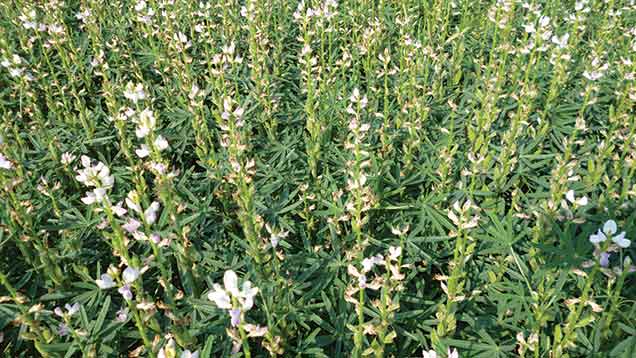How lupins can save on livestock feed costs

Lupins could be grown on virtually every livestock farm in the UK, helping to plug the protein gap and reducing the country’s reliance on imported soya.
Farmers who do so will produce a livestock concentrate feed of 28-42% protein which can be harvested using a conventional combine and easily processed and stored on farm.
See also: Lupins offer poultry producers an alternative to soya
Earlier obstacles to growing combinable lupins have been largely overcome while animal growth rates attainable are at least equivalent to those from soya.
Lamb trial
These are among the conclusions of a three-year research project – involving 10 industry partners and two universities – whose findings have been reported this month.
Included in the project was a trial involving lambs which were fed crimped lupins with crimped barley, and assessed against those on a comparable commercial finisher diet.
Christina Marley, who undertook the trial at Aberystwyth University, said there were no statistical differences in the performance of lambs on the two rations, but that the lupin diet would save the producer £3.64 a lamb.
Preserving lupins
Andy Strzelecki from feed preservation specialists, Kelvin Cave, says that by crimping lupins – using a contractor to crimp the grain and apply the relevant preservative – the crop could be harvested in August or September at a high moisture content (up to 30%) and clamped, sealed and stored in a small silage pit or plastic tube.
See also: Insects could replace soya in poultry feed
Other methods of preservation include propionic acid if harvested at between 17% and 25% moisture, or drying the lupins down to a moisture content below 17% and storing without preservative.
This range of storage options meant combinable lupins could be grown on a wide cross-section of farms, he added.
Scope for vast increase
David McNaughton from protein crop specialist Soya UK remarks that about 80% of lupins are currently grown for wholecrop forage, but says there is scope for a vast increase in acreage of combinable lupins.
“Lupins have a huge constituency of potential growers – virtually every livestock farmer with a spare field can grow them wherever he is, for either foraging or combining,” he says.
Blue lupins are more likely to suit the north and west while whites could be grown in the south and east and will tolerate more alkaline soils.
“If we want to make a hole in the three million tonnes of soya we import, the answer is to grow lupins on livestock and arable farms,” he says.
Lupins are more resistant to bad weather than other legumes such as peas or beans; they have a more favourable amino acid profile as a livestock feed; and they contain more by-pass protein, which is important for high-performance ruminants, particularly dairy cows.
Farmer view: Andy Ray, Angus
Andy Ray has been growing lupins in Angus, north of Dundee, on his 200ha arable farm since 2003, harvesting at any time between September and December at a moisture content of 15-25%, and drying when necessary to 16-17%.
Selling to a neighbouring farmer who finishes bull beef at under 12 months on rolled lupins, barley and sugar beet, he says the selling price is usually about £50-£100 less than that of soya and that growing costs are about £247/ha.
Yielding 2.5-3.7t/ha, he says he will continue to grow lupins as part of his rotation because they thrive on his poorest soils where he has little alternative as a break from cereals.
“Their deep roots also effectively subsoil the sandy land and they are aggressive fixers of nitrogen, fixing far more than either peas or beans,” he adds.
“I can grow wheat crops of 4t/acre on fairly poor soil after lupins compared with around 3t following any other crop, and I also use around 40kg/acre less bagged nitrogen.”
Questioning why more producers didn’t grow lupins, he believes there is a tendency for farmers to stick with traditional ways and a reluctance from feed mills to allocate bins to the crop.
However, presenting findings from the trial, Emyr Jones from Wynnstay suggested the feed manufacturer was likely to allocate a raw material bin to lupins if an annual commitment from growers could be given of at least 2,000t.
The three year LUKAA research project (Lupins in UK Agriculture and Aquaculture) was funded by industry partners with Innovate UK (formerly the Technology Strategy Board) and the Biotechnology and Biological Sciences Research Council (BBSRC).
